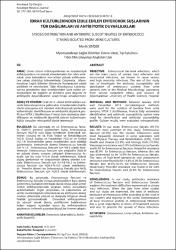| dc.contributor.author | Şimşek, Merih | |
| dc.date.accessioned | 2021-05-05T22:17:17Z | |
| dc.date.available | 2021-05-05T22:17:17Z | |
| dc.date.issued | 2019 | |
| dc.identifier.issn | 1302-4612 | |
| dc.identifier.issn | 2149-7869 | |
| dc.identifier.uri | https://app.trdizin.gov.tr/makale/TXpjNU5USTJOZz09 | |
| dc.identifier.uri | https://hdl.handle.net/20.500.12933/702 | |
| dc.description.abstract | AMAÇ: Üriner sistem enfeksiyonlarının ve nozokomiyal enfeksiyonların en önemli etkenlerinden biri olan enterokok cinsi bakterilerin mortalitesi yüksek enfeksiyonlara sebep olabildiği bilinmektedir. Çalışmada, Afyonkarahisar Sağlık Bilimleri Üniversite hastanesinin çeşitli poliklinik ve servislerden Tıbbi Mikrobiyoloji Laboratuvarı’na gönderilen idrar örneklerinden izole edilen enterokokların tür dağılımı ve kliniklere göre dağılımı ile antibiyotik duyarlılıklarının araştırılması amaçlanmıştır. GEREÇ VE YÖNTEM: Ocak 2014 - Aralık 2018 tarihleri arasında laboratuvarımıza gelen idrar örneklerinden bakterilerin izolasyonu için standart mikrobiyolojik yöntemler kullanılmıştır. İdentifikasyon ve antibiyotik duyarlılık profili için VITEK 2 (bioMerieux, France) tam otomatize identifikasyon ve antibiyotik duyarlılık sistemi kullanılmıştır. Kültür sonuçları retrospektif olarak taranmıştır. BULGULAR: Bu çalışmada en sık Enterococcus faecalis (%69.1) üremesi gözlenirken bunu Enterococcus faecium (%27.6) türü takip etmektedir. Enterokok türlerinin sırasıyla en sık Fizik Tedavi ve Rehabilitasyon (%23), Çocuk Sağlığı ve Hastalıkları (%22.6) ve Üroloji (%11.9) birimlerinden gelen örneklerden izole edildiği gözlenmiştir. Vankomisin direnci Enterococcus faecalis için %1.9, Enterococcus faecium için %6.3 olarak belirlenmiştir. Enterococcus faecium için ampisillin (%83.9) en yüksek direnç oranına sahipken Enterococcus faecalis için bu oran %10.6 olarak belirlenmiştir. Yüksek düzey gentamisin ve streptomisin direnç oranları sırasıyla, Enterococcus faecalis için %14.8-%6.2 ve Enterococcus faecium için %36.4-%10.5 olarak belirlenmiştir. Penisilin direnci ise Enterococcus faecalis için %4.8, Enterococcus faecium için %20.3 olarak belirlenmiştir. SONUÇ: Bu çalışmada, Enterococcus faecium ve Enterococcus faecalis’ in bazı antibiyotiklere karşı direnç göstermesi, bu bakterilere bağlı olarak ortaya çıkan üriner sistem enfeksiyonlarında yaşanan tedavi zorluklarını açıklamaktadır. Diğer çalışmalara ve çalışmamıza ait veriler incelendiğinde enterokoklar da antibiyotik direnç oranları ülkemizde yöresel ve dünyada bölgesel olarak farklılık göstermektedir. Enterokok enfeksiyonların da yöresel olarak direnç profillerinin belirlenmesi tedavi başarısı açısından ayrıca bu enfeksiyonların yayılmasını önlemek açısından büyük bir öneme sahiptir | en_US |
| dc.description.abstract | OBJECTIVE: Enterococcal bacterial infections, which are the main cause of urinary tract infections and nosocomial infections, are known to cause serious and high mortality infections. The aim of this study was to investigate the antibiotic susceptibility and distribution of enterococci isolated from urine samples sent to the Medical Microbiology Laboratory from various outpatient clinics and services of Afyonkarahisar University of Health Sciences Hospital. MATERIAL AND METHODS: Between January 2014 and December 2018, microbiological methods were used for the isolation of bacteria from urine samples. VITEK 2 (bioMerieux, France) fully automated identification and antibiotic susceptibility system were used for identification and antibiotic susceptibility profile. Culture results were evaluated retrospectively. RESULTS: In our study, Enterococcus faecalis (69.1%) was the most common in this study. Enterococcus faecium (27.6%) was the second. Enterococci were most frequently observed in urine specimens sent from Physical Therapy and Rehabilitation (23%), Child Health and Disease (22.6%) and Urology Units (11.9%). Vancomycin resistance was 1.9% for Enterococcus faecalis and 6.3% for Enterococcus faecium. Ampisillin resistance was 83.9% for Enterococcus faecium, whereas this rate was determined to be 10.6% for Enterococcus faecalis. The rates of high-level gentamicin and streptomycin resistance were found to be 14.8%-6.2% for Enterococcus faecalis and 36.4%-10.5% for Enterococcus faecium, respectively. Penicillin resistance was found to be 4.8% for Enterococcus faecalis and 20.3% for Enterococcus faecium. CONCLUSIONS: In our study, antibiotics resistance of Enterococcus faecium and Enterococcus faecalis explains the treatment di?iculties experienced in urinary tract infections. When the data from other studies and our study are examined, the rates of antibiotic resistance of enterococci di?er according to the local in our country and regional in the world. Determination of local resistance profiles in enterococcal infections has a great importance in terms of treatment success and also to prevent the spread of these infections | en_US |
| dc.language.iso | tr | |
| dc.relation.ispartof | Kocatepe Tıp Dergisi | |
| dc.rights | info:eu-repo/semantics/openAccess | en_US |
| dc.subject | [No Keywords] | en_US |
| dc.title | İdrar kültürlerinden izole edilen enterokok suşlarının tür dağılımları ve antibiyotik duyarlılıkları | en_US |
| dc.title.alternative | SPECIES DISTRIBUTION AND ANTIBIOTIC SUSCEPTIBILITIES OF ENTEROCOCCI STRAINS ISOLATED FROM URINE CULTURES | en_US |
| dc.type | Article | |
| dc.identifier.orcid | 0000-0003-2484-5609 | |
| dc.department | AFSÜ, Tıp Fakültesi, Temel Tıp Bilimleri Bölümü, Tıbbi Mikrobiyoloji Ana Bilim Dalı | en_US |
| dc.institutionauthor | Şimşek, Merih | |
| dc.identifier.volume | 20 | en_US |
| dc.identifier.issue | özel sayı | en_US |
| dc.identifier.startpage | 177 | en_US |
| dc.identifier.endpage | 182 | en_US |
| dc.relation.publicationcategory | Makale - Ulusal Hakemli Dergi - Kurum Öğretim Elemanı | en_US |
| dc.department-temp | - | en_US |
| dc.indekslendigikaynak | TR-Dizin | |
















